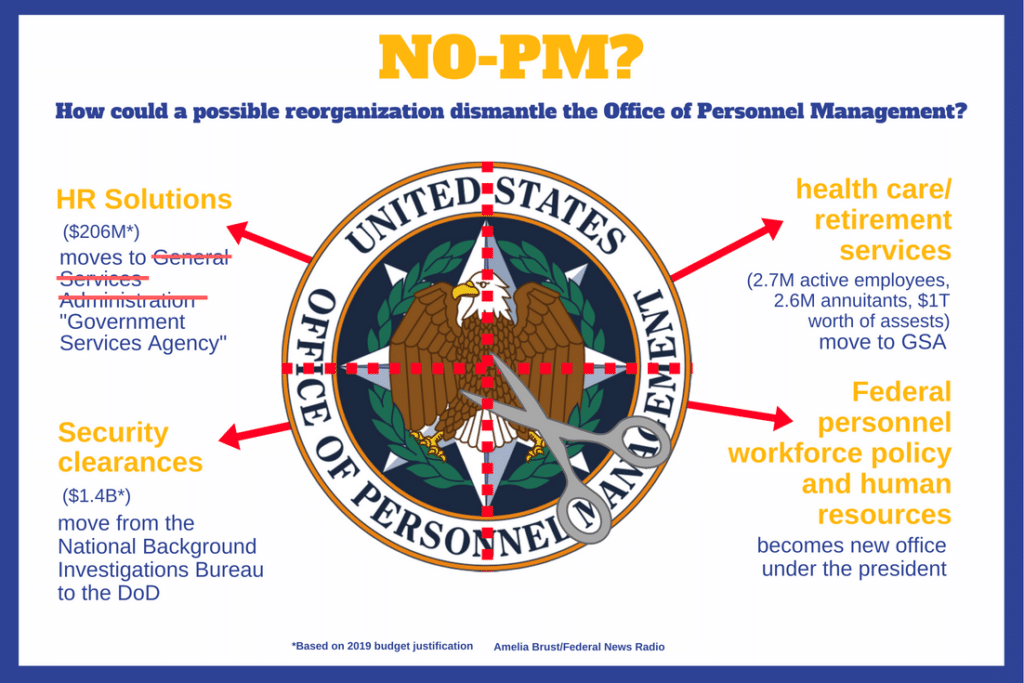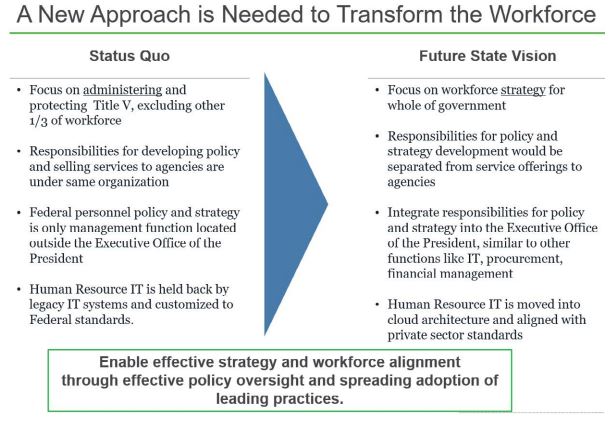 Exclusive
Exclusive Trump reorg report proposes significant shift of OPM services
The administration also proposes moving OPM's current retirement services and health care and insurance offices to the General Services Administration, which would...
Best listening experience is on Chrome, Firefox or Safari. Subscribe to Federal Drive’s daily audio interviews on Apple Podcasts or PodcastOne.
In what it described as attempt to elevate the status of the federal workforce, the Trump administration on Thursday proposed a massive reorganization of the Office of Personnel Management.
The White House released its long-awaited reorganization report, which follows the executive order the president signed last spring and subsequent agency guidance from the Office of Management and Budget. It proposes a wide variety of moves, transfers and consolidations of departments, agencies and subcomponents across government.
Perhaps most notably for federal employees, the administration proposes a significant shift of OPM’s existing functions to other agencies in government, as Federal News Radio previously reported.

In its reorganization report, the administration painted OPM as an organization comprised of a chaotic array of functions — and as an agency that’s been distracted by a series of high-profile data breaches and investigative backlogs.
Currently, more than 80 percent of the OPM workforce and funding is dedicated to processing federal employee health and retirement benefits, security clearances and managing USAJOBS.gov.
These jobs are important, the Office of Management and Budget said, but “distract the agency leadership’s attention from strategic human capital management and stewardship of an efficient civil service structure.”
Related Stories
“The people who focus on the merit systems principles and on the workforce needs of the federal government and how they need to evolve to meet the mission, that’s frankly the part of OPM’s mission that’s gotten lost under the burden of all these transaction processes, most of which are very paper intensive,” Margaret Weichert, OMB’s deputy director for management, told reporters Thursday. “We’re really trying to get back to the core of the merit system principles.”
Specifically, the reorganization report suggests moving OPM’s current “employee services” offices, which include employee relations, merit system accountability and compliance, hiring and other human capital functions. They would move to a new entity within the Executive Office of the President.
This office would develop specific workforce policies, procedures and incentives across government, while modernizing the current approach to human resources policy, senior talent and leadership development and “total compensation and employee performance,” the report said.
“Once complete a transition into the EOP could create a more streamlined personnel management unit that is less expensive to operate,” the administration wrote. “Such a unit would also support centralized coordination of all personnel policies for federal employees, eliminating the confusing matrix of who does what today, as well as several key gaps in policy that are inhibiting the streamlining of mission support services.”
The new EOP office would centralize human resources policy for the entire federal workforce, while focusing on the administration’s efforts to modernize the current civil service.

The Senior Executives Association praised the idea, likening the office to an executive-level human capital function within a major corporation.
“The added emphasis on OPM’s core functions of providing human capital policy and oversight solve many problems that have for nearly two decades plagued federal human capital processes and practices,” SEA President Bill Valdez said in a statement.
But the American Federation of Government Employees called the move of OPM’s policy offices to the White House “a straightforward attempt to politicize the civil service.”
Federal employee health and retirement
The administration also proposes moving OPM’s current retirement services and health care and insurance offices to the General Services Administration, which would be renamed the “Government Services Agency.”
The Government Services Agency would maintain GSA’s existing functions and absorb OPM’s current transactional, service-based services, like retirement and health care.
“With end-to-end services around the federal employee lifecycle maintained in one place, considerable operational efficiencies should be attained,” the administration wrote. “Currently, these services are stove-piped, forcing burdensome processes on managers and employees.”
OPM currently administers health and retirement benefits to more than 2.7 million active employees and nearly 2.6 million annuitants, survivors and their family members through the Earned Benefits Trust Funds, which have close to $1 trillion in combined assets.
Security clearances, HR Solutions
HR Solutions, which currently offers products and services to help agencies with their human resources needs, would also move from OPM to the newly renamed GSA.
In addition, the administration proposes a transfer of the entire governmentwide security clearance portfolio, currently housed within OPM’s National Background and Investigations Bureau (NBIB), to the Pentagon.
The Trump administration has long considered this transfer, particularly after Congress authorized the Defense Department to begin a three-year plan to resume responsibility for all defense-related investigative work.
DoD would serve as the primary governmentwide security clearance provider, a responsibility OPM held since the Pentagon first gave up the program in 2005.
OPM currently charges agencies fees to conduct background investigations and provide HR services, such as staffing and hiring assistance. But the Trump administration sees these business operations as a conflict of interest.
“There is no significant benefit obtained from having these operational fee-based functions housed within the same agency that oversees the overarching policies,” the administration wrote. “Further, it is in no way apparent that OPM has a comparative advantage relative to other federal entities in the management of information technology or contractual services. Also, in selling human resources and IT products to those agencies whose personnel practices it monitors, OPM is in a position that can lend the appearance of a conflict of interest.”
Unanswered questions
The administration’s proposal leaves several open questions, a point that OMB was quick to acknowledge.
“While the precise transition plan for all units has not been finalized, organizational units in the EOP
office would subsume and expand upon the current OPM human capital policy-based activities under
this proposal,” the report reads.
The future of OPM’s current leadership is also in question under this proposal. Though the administration’s report doesn’t explicitly say the agency would be abolished, OMB suggested transferring practically all of OPM’s current functions.
The report also tasks both the OMB and OPM directors with the change-management and capacity building process to set up a federal personnel office within the White House. In addition, the OPM director would retain the responsibility of the governmentwide suitability executive agent,” who manages policies on whether employees and contractors are “fit” to serve in government.
Weichert said the administration’s broader reorganization efforts are not an attempt to cut federal jobs.
In addition, finalizing these moves would require both congressional action and administrative actions, the report acknowledged. Congress authorized OPM as an independent agency in the Civil Service Reform Act of 1978.
The 2018 omnibus, which which Congress passed in March, appears to complicate the Trump administration’s reorganization initiatives by prohibiting agencies from cutting or eliminating specific programs or offices without approval from lawmakers.
At the same time, Weichert described the proposal to elevate OPM’s human resources functions and transfer the security clearance program as moves the administration could do today.
The House Oversight and Government Reform Committee has a hearing scheduled on the administration’s reorganization report for next week.
The president’s reorganization proposals so far have earned mixed reviews from Congress.
“The vast majority of people I ask believe the federal government is badly broken,” Senate Homeland Security and Governmental Affairs Committee Chairman Ron Johnson (R-Wis.) said in a statement. “This is why I am so pleased to see this administration thinking big and ‘outside of the box’ to bring effective reform and reorganization to a government structure developed for the previous century.”
But Rep. Gerry Connolly (D-Va.), ranking member of the House oversight government operations subcommittee, slammed the administration’s proposal. He specifically criticized the recommendation to move federal employee health and retirement benefits out of OPM, adding the moves would “at precisely the wrong time.”
“There are ways to improve efficiency and modernize the federal government,” he said in a statement. “This isn’t it.”
Copyright © 2025 Federal News Network. All rights reserved. This website is not intended for users located within the European Economic Area.
Nicole Ogrysko is a reporter for Federal News Network focusing on the federal workforce and federal pay and benefits.
Follow @nogryskoWFED





